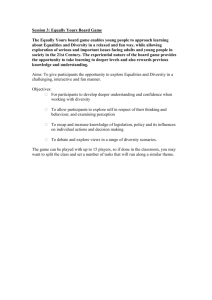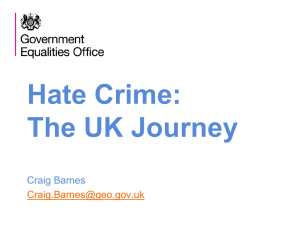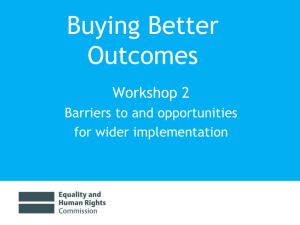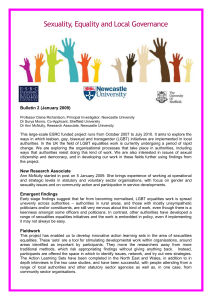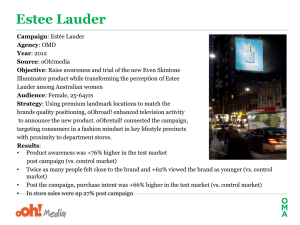Promoting Social and Economic Equalities in Mental Health Social
advertisement
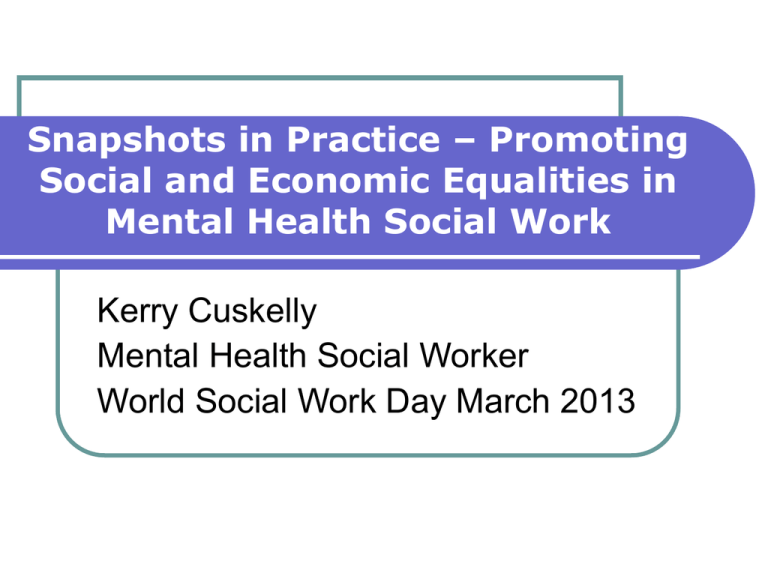
Snapshots in Practice – Promoting Social and Economic Equalities in Mental Health Social Work Kerry Cuskelly Mental Health Social Worker World Social Work Day March 2013 Mental Health Social Work Disclaimer! This presentation contains the thoughts of one team from one area. We do not presume to be speaking for all mental health services and social workers. Context – Vision for Change Other parameters/considerations – Human rights frameworks, Global Agenda for Social Work, Mental Health Commission, IASW code of ethics, CORU code of ethics, social model of mental health The MH teams A Vision For Change – The Social Model of Health and Mental Health Chapter four: “Belonging and Participation: Social Inclusion”, “Community development models of mental health are particularly useful in the provision of mental health services to culturally diverse groups. Services need to reach out actively to communities to find alternative paths to channel support to individuals and families”. Chapter eleven: “General Adult Mental Health Services”, “...A large body of evidence identifies the community as a key setting for health promotion activities. The WHO123 emphasizes the importance of a person-centred approach to community development where the focus is on developing the social, economic, environmental, and cultural well-being of communities, in particular its marginalised members”. A Vision For Change – The Social Model of Health and Mental Health Chapter thirteen, “Mental Health Services for Older People”, “Social support is a key resource for older people. Self help, support networks and volunteering have been identified as protective factors against poor mental health as well as helping people recover from stressful life events like bereavement. The evidence suggests that these interventions are most successful when linked closely with other community development initiatives. It is recommended that evidencebased beneficial and effective programmes for older adults should be implemented”. A clear indication of the importance of the inclusion of the social model of mental health and community development approaches in mental health is articulated in chapter 2: “Mental health problems affect society as a whole. This emphasis on the social importance of mental health (and therefore the importance of a society-wide response to mental health) is increasingly emphasised by the World Health Organisation (WHO): ‘for all individuals, mental, physical and social health are closely interwoven … As our understanding of this interdependent relationship grows, it becomes ever more apparent that mental health is crucial to the overall well-being of individuals, societies and countries.’ (p. 7)” What the Continued Cuts Have Meant for Mental Health In our MH services – Three day centres (2 general adult, 1 rehab) have closed down in the past 3 months (On paper they are open, in reality they aren’t). Home care packages have been eviscerated (On paper they were restored to 2012 levels, in reality they aren’t). Home help does not exist anymore (On paper it does, in reality it doesn’t). There is no day hospital or day centres at all for older persons (approx. 26,000 people/400 open caseload). What the Continued Cuts Have Meant for Mental Health There is only one older persons MDT to cover all of our catchment area. There is only one rehabilitation MDT to cover all of our catchment area. There is a constant bed crisis in the general adult acute inpatient unit. There is only 1 social worker on the older person and rehab team when there should be 2.5 SW posts on each team. There is only 1 social worker on all the general adult teams. All new CMH staff that began in 2013 are not being given any office equipment with which to do their jobs due to “budget curtailments”. There is no service user representation on the area management team. A growing issue with homelessness and mental health A growing issue re. Housing and mental health Continued Challenges Ahead This is all happening in the context of – The service plan for the area was published two weeks ago. It outlines the key challenges to progressing MH services in our area in 2013 The number of retirements will be an issue. Improvements will be necessary to support delivery of services and prevent unplanned bed closures below the national target levels or disruption to community services. Due to staff shortages meeting legislative requirements might be an issue. In order to reduce the amount of people using inpatient services additional staff is needed to fill the additional community posts. If these staff are hired providing adequate supervision might be an issue as they will mostly basic grade posts. Nursing home placements have been identified as the place for long stay MH service users to go to with staff being redeployed “elsewhere” when this occurs. However, nursing home beds remain in short supply. How Can We Promote Social and Economic Equalities in This Context? It’s getting much harder. But we are fighting back by…. Using peer supervision and informal supervision to theorise our work and experiences. Building a strong, united, collective social work team. Building alliances with other H&SCP’s to build strong, united and collective MDT’s. Challenging the rhetoric of “there is no money”. There is money, it’s just being diverted to places other than frontline staff and the frontline services which service users depend on. How Can We Promote Social and Economic Equalities in this Context? Using the social model of mental health – viewing mental health issues not as something that is a “disease” or a “chemical imbalance in the brain” but rather viewing mental health as connected to many outside aspects on one’s life – poverty, abuse, discrimination, trauma, bereavement etc. Using the “Social Determinants of Health” (Dahlgren and Whitehead, 1991) as a guide for this work. Challenging the gaping hole in communication between management and staff/service users. Social Determinants of Health How Can We Promote Social and Economic Equalities in this Context? Using Direct Action – Home Care Package campaign in the last quarter of 2012. PCSW and MHSW worked together to mobilise SW’s in North Dublin. Also, mobilised as many service users, families and home help staff as possible. Collected over 300 signatures for petition. Handed these in with the 10,000 other signatures collected. Marched with home help staff, SU’s and families on demonstration on November 24th. Campaign succeeded in getting home help hours reinstated to Jan 2012 levels. Building alliances/relationships with community organisations eg. During home help campaign, very positive relationship made with Older and Bolder who supplied us with tons of postcards, posters, info to hand out to people re the cuts to home help. They also intended on working with us re. mental health and older persons after the campaign. Unfortunately, their funding has been ended so this piece of work will not happen. Using grassroots groups like the Social Work Action Network (SWAN) as safe spaces in which to challenge the continued cuts to services and the injustices we see first hand every day e.g. we marched under this banner in the November 24th demonstration. Questions? Thank you!
